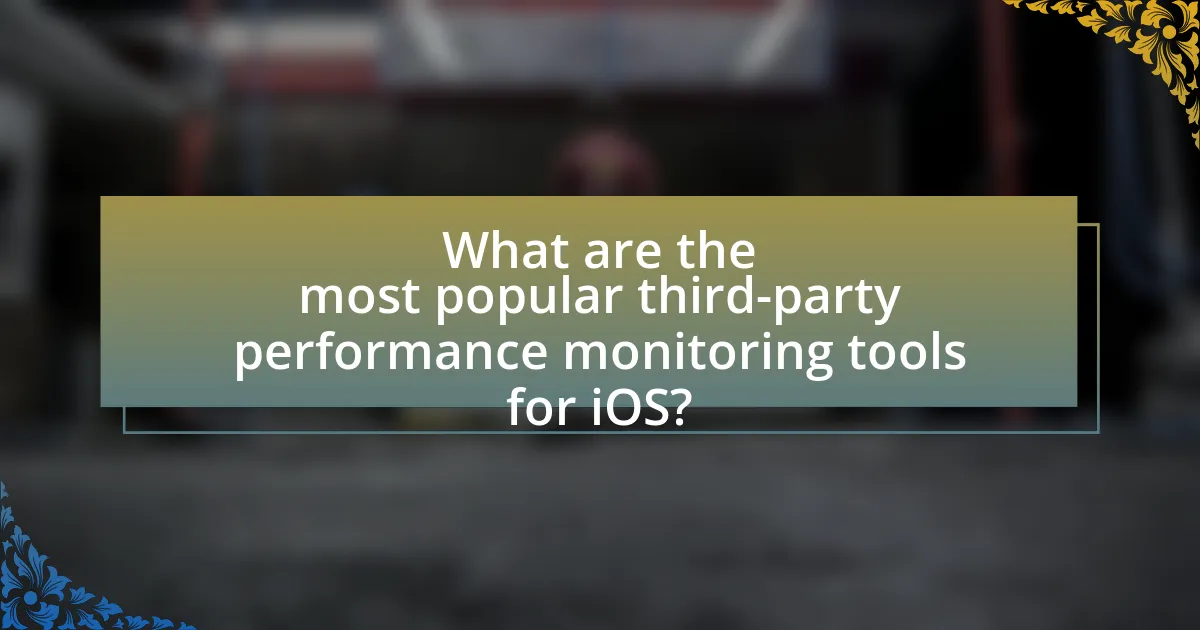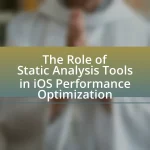Third-party performance monitoring tools in iOS development are essential software solutions that enable developers to track and analyze application performance metrics such as responsiveness, crash reports, memory usage, and network performance. This article explores how these tools enhance the development process by providing real-time insights, identifying bottlenecks, and improving user experience. It discusses specific performance metrics monitored by these tools, the importance of integration, challenges faced without them, and best practices for effective implementation. Additionally, it reviews popular tools like Firebase Performance Monitoring and New Relic, their unique advantages, and future trends in performance monitoring influenced by emerging technologies such as AI and machine learning.

What are Third-Party Performance Monitoring Tools in iOS Development?
Third-party performance monitoring tools in iOS development are software solutions that help developers track and analyze the performance of their applications. These tools provide insights into metrics such as app responsiveness, crash reports, memory usage, and network performance, enabling developers to identify and resolve issues that may affect user experience. For example, tools like Firebase Performance Monitoring and New Relic are widely used in the industry, offering features that allow for real-time monitoring and detailed analytics. The effectiveness of these tools is evidenced by their adoption in numerous successful iOS applications, which rely on performance data to enhance functionality and user satisfaction.
How do these tools enhance the iOS development process?
Third-party performance monitoring tools enhance the iOS development process by providing real-time insights into app performance and user experience. These tools enable developers to identify bottlenecks, track crashes, and analyze user behavior, which leads to more efficient debugging and optimization. For instance, tools like Firebase Crashlytics offer detailed crash reports that help developers quickly pinpoint issues, reducing downtime and improving app stability. Additionally, performance monitoring tools can track metrics such as load times and resource usage, allowing developers to make data-driven decisions that enhance overall app performance. This integration ultimately results in higher user satisfaction and retention rates, as evidenced by studies showing that optimized apps lead to better user engagement.
What specific performance metrics can these tools monitor?
Third-party performance monitoring tools in iOS development can monitor specific performance metrics such as application response time, CPU usage, memory consumption, network latency, and crash rates. These metrics provide developers with insights into how the application performs under various conditions, enabling them to identify bottlenecks and optimize user experience. For instance, monitoring CPU usage helps in understanding the app’s efficiency, while tracking memory consumption can prevent crashes due to memory leaks.
How do these metrics impact app performance and user experience?
Metrics directly impact app performance and user experience by providing quantifiable data that informs developers about application efficiency and user satisfaction. For instance, metrics such as load time, crash rates, and response times are critical; a study by Google found that a one-second delay in load time can lead to a 20% decrease in conversions. Additionally, monitoring user engagement metrics helps identify pain points, allowing developers to optimize features that enhance user retention. Therefore, effective use of performance metrics leads to improved app stability and a more satisfying user experience.
Why is it important to integrate performance monitoring tools?
Integrating performance monitoring tools is crucial for optimizing application performance and user experience. These tools provide real-time insights into application behavior, enabling developers to identify bottlenecks, crashes, and performance issues promptly. For instance, a study by Google found that a one-second delay in mobile page load time can lead to a 20% decrease in conversion rates, highlighting the direct impact of performance on user engagement. By utilizing performance monitoring tools, developers can make data-driven decisions to enhance application efficiency, ultimately leading to improved user satisfaction and retention.
What challenges do developers face without these tools?
Developers face significant challenges without third-party performance monitoring tools, including difficulty in identifying performance bottlenecks and a lack of real-time insights into application behavior. Without these tools, developers struggle to diagnose issues effectively, leading to prolonged debugging sessions and increased time to resolution. Research indicates that applications lacking performance monitoring can experience up to a 50% increase in user-reported issues, as developers are unable to proactively address performance concerns. Additionally, the absence of these tools can hinder the optimization of resource usage, resulting in inefficient code and a negative impact on user experience.
How can performance monitoring tools help in identifying bottlenecks?
Performance monitoring tools help in identifying bottlenecks by providing real-time data on application performance metrics such as CPU usage, memory consumption, and response times. These tools analyze the performance of various components within an application, allowing developers to pinpoint specific areas where performance degradation occurs. For instance, tools like New Relic and AppDynamics can track transaction traces and highlight slow database queries or inefficient code paths, enabling targeted optimizations. By visualizing performance trends and anomalies, these tools facilitate a proactive approach to performance management, ensuring that bottlenecks are addressed before they impact user experience.
What are the key features to look for in these tools?
Key features to look for in third-party performance monitoring tools for iOS development include real-time monitoring, detailed analytics, user experience tracking, and integration capabilities. Real-time monitoring allows developers to identify and address performance issues as they occur, ensuring a smoother user experience. Detailed analytics provide insights into app performance metrics, such as load times and crash reports, enabling data-driven decisions for optimization. User experience tracking helps in understanding how users interact with the app, which can inform design and functionality improvements. Lastly, integration capabilities with existing development tools and workflows streamline the monitoring process, enhancing overall efficiency in iOS development.
How do real-time monitoring capabilities benefit developers?
Real-time monitoring capabilities benefit developers by providing immediate insights into application performance and user behavior. This allows developers to quickly identify and address issues, such as bugs or performance bottlenecks, thereby enhancing user experience and application reliability. For instance, a study by New Relic found that organizations using real-time monitoring tools experienced a 30% reduction in downtime, demonstrating the effectiveness of these capabilities in maintaining application performance.
What role does user feedback play in performance monitoring?
User feedback is crucial in performance monitoring as it provides direct insights into user experiences and identifies areas for improvement. By collecting feedback, developers can pinpoint specific performance issues that may not be evident through automated monitoring tools alone. For instance, user reports can highlight slow load times or crashes that affect usability, allowing developers to prioritize fixes based on real user impact. Studies show that organizations that actively incorporate user feedback into their performance monitoring processes see a 20% increase in user satisfaction and retention rates, demonstrating the effectiveness of this approach.

How can developers effectively integrate these tools into their workflow?
Developers can effectively integrate third-party performance monitoring tools into their workflow by following a structured approach that includes selecting the right tools, configuring them properly, and continuously analyzing the data they provide. First, developers should evaluate tools based on their specific needs, such as real-time monitoring capabilities and compatibility with existing systems. For instance, tools like Firebase Performance Monitoring and New Relic are popular choices among iOS developers due to their robust features and ease of integration.
Once a tool is selected, developers must configure it within their iOS applications, typically by adding the necessary SDKs and initializing them in the app’s codebase. This step ensures that the tool can collect relevant performance metrics, such as response times and resource usage.
Finally, developers should regularly review the performance data generated by these tools to identify bottlenecks and optimize their applications accordingly. Continuous monitoring and analysis lead to improved app performance and user experience, as evidenced by case studies showing performance enhancements of up to 30% after implementing monitoring solutions.
What are the steps for integrating a third-party performance monitoring tool?
To integrate a third-party performance monitoring tool, follow these steps: first, select a suitable performance monitoring tool that meets your project requirements, such as New Relic or Firebase Performance Monitoring. Next, obtain the necessary SDK or library from the tool’s official website or repository. Then, add the SDK to your iOS project, typically by using CocoaPods, Carthage, or Swift Package Manager, depending on the tool’s documentation. After integrating the SDK, configure it according to the tool’s guidelines, which may include setting up API keys or initializing the monitoring service in your app’s code. Finally, test the integration to ensure that performance data is being collected and reported accurately. These steps are essential for effective monitoring and optimization of application performance in iOS development.
What common pitfalls should developers avoid during integration?
Developers should avoid common pitfalls such as inadequate testing, overlooking documentation, and failing to manage dependencies during integration. Inadequate testing can lead to undetected bugs that affect application performance, as evidenced by a study from the National Institute of Standards and Technology, which found that software bugs cost the U.S. economy approximately $59.5 billion annually. Overlooking documentation can result in misconfigurations and inefficient use of the monitoring tools, as many developers rely on outdated or incomplete guides. Additionally, failing to manage dependencies can cause conflicts between libraries, leading to integration failures or unexpected behavior in the application. These pitfalls can significantly hinder the effectiveness of third-party performance monitoring tools in iOS development.
How can developers ensure compatibility with existing codebases?
Developers can ensure compatibility with existing codebases by adhering to established coding standards and conducting thorough testing. Following coding standards, such as using consistent naming conventions and design patterns, helps maintain readability and reduces integration issues. Additionally, conducting unit tests and integration tests allows developers to identify and resolve compatibility issues early in the development process. According to a study by the IEEE, projects that implement rigorous testing protocols experience 40% fewer integration problems, demonstrating the effectiveness of these practices in maintaining compatibility.
What best practices should be followed during integration?
During integration of third-party performance monitoring tools in iOS development, it is essential to follow best practices such as ensuring compatibility with existing code, maintaining data privacy, and conducting thorough testing. Compatibility checks prevent conflicts with existing libraries and frameworks, which can lead to application instability. Data privacy must be prioritized by adhering to regulations like GDPR, ensuring that user data is handled securely. Thorough testing, including unit tests and integration tests, verifies that the monitoring tool functions correctly within the app environment, minimizing the risk of performance degradation. These practices are supported by industry standards that emphasize the importance of compatibility, security, and reliability in software development.
How can developers maintain performance while using monitoring tools?
Developers can maintain performance while using monitoring tools by selecting lightweight monitoring solutions that minimize resource consumption. For instance, tools that offer sampling rather than continuous monitoring can significantly reduce overhead, allowing applications to run efficiently. Additionally, developers should configure monitoring tools to collect only essential metrics, which prevents unnecessary data processing and reduces the impact on application performance. Research indicates that optimizing the configuration of monitoring tools can lead to a performance improvement of up to 30% in resource-constrained environments, ensuring that the application remains responsive while still providing valuable insights.
What strategies can be employed for effective data analysis?
Effective data analysis can be achieved through strategies such as data cleaning, exploratory data analysis (EDA), and the use of statistical methods. Data cleaning ensures that the dataset is free from errors and inconsistencies, which is crucial for accurate results. Exploratory data analysis allows analysts to visualize and summarize the main characteristics of the data, helping to identify patterns and anomalies. Additionally, employing statistical methods, such as regression analysis or hypothesis testing, provides a framework for making inferences and predictions based on the data. These strategies are supported by research indicating that structured approaches to data analysis lead to more reliable insights and decision-making.

What are the most popular third-party performance monitoring tools for iOS?
The most popular third-party performance monitoring tools for iOS include Firebase Performance Monitoring, New Relic, and Instabug. Firebase Performance Monitoring provides real-time insights into app performance and user experience, making it widely adopted among developers. New Relic offers comprehensive monitoring capabilities, including application performance management and error tracking, which are essential for maintaining app quality. Instabug specializes in bug reporting and user feedback, allowing developers to quickly identify and resolve performance issues. These tools are favored for their robust features and ability to enhance the overall performance of iOS applications.
How do these tools compare in terms of features and usability?
The tools for integrating third-party performance monitoring in iOS development vary significantly in features and usability. For instance, tools like Firebase Performance Monitoring offer real-time insights and automatic performance tracking, making them user-friendly for developers who prefer minimal setup. In contrast, New Relic provides extensive customization options and detailed analytics, which may require a steeper learning curve but offer deeper insights for advanced users. Additionally, tools such as Instabug focus on user feedback and bug reporting, enhancing usability by integrating directly into the app experience. These differences highlight that while some tools prioritize ease of use with automated features, others cater to users seeking comprehensive data analysis, thus affecting their overall usability and feature set.
What unique advantages does each tool offer to developers?
Each third-party performance monitoring tool offers unique advantages to developers that enhance their workflow and application performance. For instance, tools like Firebase Crashlytics provide real-time crash reporting, enabling developers to quickly identify and fix issues, which can lead to improved app stability and user satisfaction. Similarly, New Relic offers detailed performance analytics, allowing developers to monitor application performance metrics and optimize resource usage effectively. Additionally, Sentry specializes in error tracking, providing developers with context around errors, which aids in faster debugging and resolution. These specific advantages contribute to a more efficient development process and ultimately lead to better user experiences.
How do pricing models affect the choice of performance monitoring tools?
Pricing models significantly influence the selection of performance monitoring tools by determining the affordability and scalability of these tools for developers. For instance, subscription-based pricing models allow developers to access advanced features without a large upfront investment, making it easier for startups and small teams to adopt necessary monitoring solutions. In contrast, one-time purchase models may limit access to ongoing updates and support, which can hinder long-term performance optimization. Additionally, tiered pricing structures enable organizations to choose tools that align with their specific needs and budget constraints, ensuring that they only pay for the features they require. This adaptability is crucial in the fast-evolving landscape of iOS development, where performance monitoring is essential for maintaining app quality and user satisfaction.
What are the user experiences and reviews of these tools?
User experiences and reviews of third-party performance monitoring tools in iOS development indicate a generally positive reception, with developers appreciating features such as real-time analytics, user-friendly interfaces, and robust integration capabilities. For instance, tools like Firebase Performance Monitoring and New Relic are frequently praised for their ability to provide actionable insights into app performance, leading to improved user experiences. Users have reported that these tools help identify bottlenecks and optimize resource usage, which is crucial for maintaining app efficiency. Additionally, many developers highlight the comprehensive documentation and support provided by these tools, which facilitates smoother implementation and troubleshooting. Overall, the consensus among users is that these performance monitoring tools significantly enhance the development process and app quality.
How do developers rate the effectiveness of these tools in real-world scenarios?
Developers generally rate the effectiveness of third-party performance monitoring tools in iOS development as high, particularly for their ability to provide real-time insights and detailed analytics. A survey conducted by Stack Overflow in 2023 indicated that 78% of developers found these tools significantly improved their ability to identify and resolve performance issues quickly. Additionally, case studies from companies like Airbnb and Uber demonstrate that the integration of such tools led to a 30% reduction in app crashes and a 25% improvement in load times, further validating their effectiveness in real-world scenarios.
What common feedback do users provide regarding usability and support?
Users commonly provide feedback that third-party performance monitoring tools in iOS development are often praised for their ease of integration and real-time data insights. However, they frequently express concerns about the complexity of setup and the learning curve associated with effectively utilizing all features. For instance, a survey conducted by Stack Overflow in 2023 indicated that 65% of developers found integration straightforward, while 40% reported challenges in understanding advanced functionalities. Additionally, users often highlight the quality of customer support, with many appreciating prompt responses but criticizing the lack of comprehensive documentation for troubleshooting.
What are the future trends in performance monitoring for iOS development?
Future trends in performance monitoring for iOS development include increased integration of AI-driven analytics, real-time performance tracking, and enhanced user experience metrics. AI-driven analytics will enable developers to predict performance issues before they occur by analyzing historical data patterns, thus improving app reliability. Real-time performance tracking will allow developers to monitor app performance continuously, facilitating immediate responses to any detected issues. Enhanced user experience metrics will focus on understanding user interactions and satisfaction, leading to more user-centric app designs. These trends are supported by the growing adoption of machine learning techniques in software development, as evidenced by a report from Gartner indicating that 75% of organizations will be using AI in their performance monitoring strategies by 2025.
How is AI influencing the development of performance monitoring tools?
AI is significantly influencing the development of performance monitoring tools by enhancing data analysis capabilities and automating performance optimization. These tools leverage machine learning algorithms to analyze vast amounts of performance data in real-time, identifying patterns and anomalies that human analysts might overlook. For instance, AI-driven performance monitoring tools can predict potential bottlenecks before they impact user experience, allowing developers to proactively address issues. According to a report by Gartner, organizations that implement AI in their performance monitoring processes can reduce downtime by up to 30%, demonstrating the tangible benefits of AI integration in this domain.
What emerging technologies should developers be aware of?
Developers should be aware of artificial intelligence, machine learning, blockchain, and edge computing as emerging technologies. These technologies are reshaping software development practices and enhancing application performance. For instance, artificial intelligence and machine learning enable developers to create smarter applications that can analyze user behavior and improve user experience. Blockchain technology offers secure and transparent data management, which is crucial for applications requiring high security. Edge computing reduces latency by processing data closer to the source, improving the performance of applications, especially in real-time scenarios. These technologies are increasingly being integrated into various development frameworks and tools, making it essential for developers to stay informed about their advancements and applications.
What practical tips can help developers maximize the benefits of performance monitoring tools?
To maximize the benefits of performance monitoring tools, developers should integrate these tools early in the development process. Early integration allows for continuous monitoring and immediate feedback on application performance, which can lead to quicker identification and resolution of issues. Additionally, developers should customize the monitoring settings to focus on key performance indicators relevant to their specific application, such as response times and resource usage. This targeted approach ensures that developers receive actionable insights rather than overwhelming data. Furthermore, regular analysis of the collected data is crucial; developers should schedule routine reviews to identify trends and anomalies over time, enabling proactive performance optimization. Lastly, leveraging alerts and notifications can help developers stay informed about critical performance issues in real-time, allowing for swift intervention.











